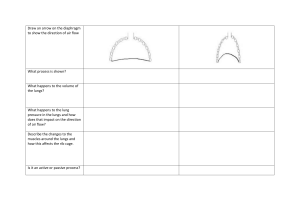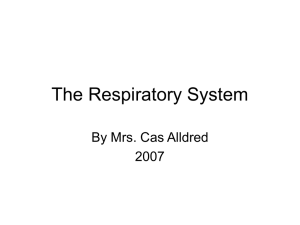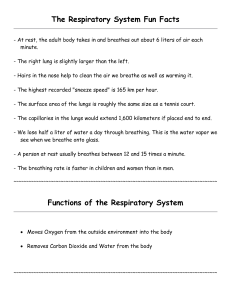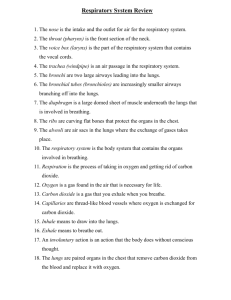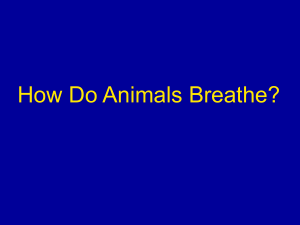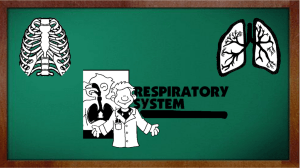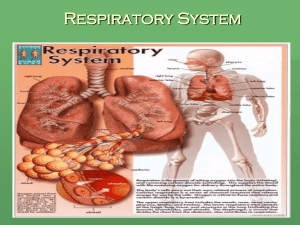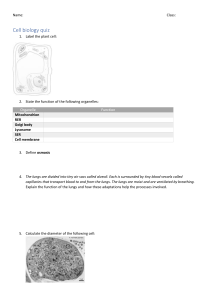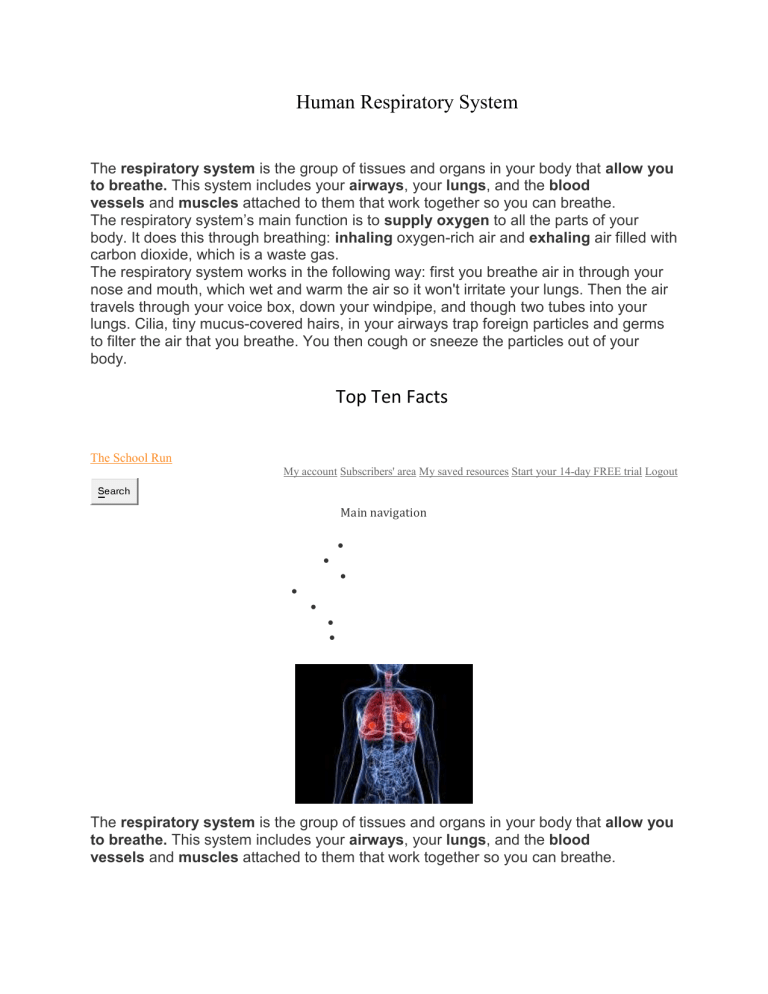
Human Respiratory System The respiratory system is the group of tissues and organs in your body that allow you to breathe. This system includes your airways, your lungs, and the blood vessels and muscles attached to them that work together so you can breathe. The respiratory system’s main function is to supply oxygen to all the parts of your body. It does this through breathing: inhaling oxygen-rich air and exhaling air filled with carbon dioxide, which is a waste gas. The respiratory system works in the following way: first you breathe air in through your nose and mouth, which wet and warm the air so it won't irritate your lungs. Then the air travels through your voice box, down your windpipe, and though two tubes into your lungs. Cilia, tiny mucus-covered hairs, in your airways trap foreign particles and germs to filter the air that you breathe. You then cough or sneeze the particles out of your body. Top Ten Facts The School Run My account Subscribers' area My saved resources Start your 14-day FREE trial Logout Main navigation Subject School Year Topics Learning Programmes Project Explorer Glossaries Bookshop Human respiratory system The respiratory system is the group of tissues and organs in your body that allow you to breathe. This system includes your airways, your lungs, and the blood vessels and muscles attached to them that work together so you can breathe. The respiratory system’s main function is to supply oxygen to all the parts of your body. It does this through breathing: inhaling oxygen-rich air and exhaling air filled with carbon dioxide, which is a waste gas. The respiratory system works in the following way: first you breathe air in through your nose and mouth, which wet and warm the air so it won't irritate your lungs. Then the air travels through your voice box, down your windpipe, and though two tubes into your lungs. Cilia, tiny mucus-covered hairs, in your airways trap foreign particles and germs to filter the air that you breathe. You then cough or sneeze the particles out of your body. Top 10 facts 1. Most vertebrate animals (animals with spines) have two lungs. 2. Your left and right lungs aren’t exactly the same. The lung on the left side of your body is divided into two lobes while the lung on your right side is divided into three. The left lung is also slightly smaller, allowing room for your heart. 3. The highest recorded "sneeze speed" is 165 km per hour. 4. The capillaries in the lungs would extend 1,600 kilometers if placed end to end. 5. We lose half a liter of water a day through breathing. This is the water vapor we see when we breathe onto glass. 6. People who have a large lung capacity can send oxygen around their body faster. You can increase you lung capacity with regular exercise. 7. As well as other parts of your body and your general health, smoking is bad for your lungs. Smoking can cause lung cancer among other lung-affecting diseases. 8. You can live with one lung – it limits your physical ability but doesn’t stop you from living a relatively normal life. Many people around the world live with just one lung. 9. The lungs are able to float on water since they contain so many air sacs. If you breathe out in a swimming pool, you start to sink as the air sacs are empty. The word "lung" originates from the Old English word "lungen". It means "light" (not heavy), probably because people realized that lungs from a slaughtered animal float in water (the heart, liver and other organs sink). Lungs vary in size just as people do. Generally adult lungs measure around 2535cm long, are 10-15cm wide and weigh 0.8-1.2 kg. Your lungs breathe in about 2,000 gallons of air every day – enough for the 2,400 gallons of blood that go through your heart every day. At night, you inhale and exhale enough air to fill your bedroom! A healthy lung is pink, smooth and shiny. People who smoke damage their lungs; a damaged lung is black, bumpy and dull. Everyone yawns at some point, but do you know why? It happens when the brain detects low oxygen levels in lungs and it triggers back the response to the body, so that it can intake large amounts of oxygen by yawning. Red blood cells are responsible for picking up the oxygen in the lungs and carry oxygen to the body cells. The red blood cells then collect the carbon dioxide (waste gas product) produced by our cells and transport the carbon dioxide back to the lungs which we breathe out when we exhale. In 1905, the scientist J S Haldane made the important discovery that the urge to breathe is caused by a build-up of carbon dioxide in the blood. As the blood level of carbon dioxide rises, this is detected by a small region in the brain, which triggers quicker breathing. The world record for longest time holding the breath underwater was 22 min 00 sec by Stig Severinsen (Denmark) at the London School of Diving in London, UK, on 3 May 2012. Stig was allowed to hyperventilate (breathe rapidly) with oxygen prior to the attempt, and did this for 19 minutes and 30 seconds. The first species of mammal shown to breathe through its skin, at least for part of its life, is the Julia Creek dunnart, a tiny species of Australian marsupial mouse. Scientists discovered that although as an adult this little creature breathes through its lungs like other mammals, when first born it is so small – only 4mm (0.15in) long – that its muscles are too weak to inflate its lungs. So it absorbs oxygen directly through its skin until it leaves its mother's pouch, by which time it is large enough to inflate its lungs. The job of your respiratory system is very simple: to bring oxygen into your body, and remove the carbon dioxide from your body. Your body needs oxygen to survive. Oxygen is used by your cells as they perform all their different jobs to keep you alive and functioning. As your body uses oxygen, your cells produce another gas known as carbon dioxide. Too much carbon dioxide can be toxic, even deadly. For this reason, it is important that your body has a way to get rid of it. The main organs in your respiratory system are your lungs. Your lungs are, in their simplest form, nothing more than air sacs. As you breathe in (inhale), you fill these sacs with fresh oxygen-rich air. Your heart pumps blood into the walls of your lungs where it absorbs oxygen and releases carbon dioxide. As you breathe out (exhale), you release the carbon dioxide-rich air into the space around you. With each breath you take, you are taking oxygen in, and putting carbon dioxide out. When air is breathed in, it passes down the trachea. This divides into two airways called main bronchi, which go to the two lungs. Each splits into smaller bronchi, which then split into bronchioles. These finish in groups of tiny air sacs called alveoli. From your lungs, blood returns back into your heart where it is pumped out to the rest of your body, carrying oxygen along with it. Your lungs are protected by your rib cage, which is made up of 12 sets of ribs. These ribs are connected to your spine in your back and go around your lungs to keep them safe. Beneath the lungs is the diaphragm, which is a dome-shaped muscle that works with your lungs to allow you to and exhale air. As you breathe in, your diaphragm contracts and flattens out. This allows it to move down, so your lungs have more room to grow larger as they fill up with air. Your rib muscles also lift the ribs up and outward to give the lungs more space. If your body cannot breathe, your cells will not get the oxygen they need. If this happens, your cells will quickly begin to die. Within only a few minutes from the time that you are not able to get breath, your body will die. That is how important breathing is. Please Write and Study definitions (google docs in google classroom), You’ll be tested on EVERYTHING!! 1. Alveoli 2. Blood vessels 3. Bronchi 4. Bronchioles 5. Capillary 6. Carbon dioxide 7. Cells 8. Diaphragm 9. Exhale 10. Inflate 11. Inhale 12. Irritate 13. Lobes 14. Lung 15. Mammal 16. Mucus 17. Organ 18. Oxygen 19. Respiratory 20. Tissues 21. Trachea 22. Vapour
